Analysis of Front and Back Stage Operations in Gourmet Restaurant
VerifiedAdded on 2020/03/04
|8
|1602
|232
Report
AI Summary
This report provides an in-depth analysis of the service experience and management challenges within a gourmet restaurant setting. It examines the significance of service encounters, highlighting how customer perceptions are shaped by both front-stage (reservation, waiting area, dining area) and back-stage (locker room, kitchen) operations. The report emphasizes the importance of employee behavior, service-scape, and the overall environment in influencing customer satisfaction and behavioral intentions. It further delves into the managerial implications of competition, customer expectations, and the need for a balanced approach to service delivery. The study concludes that a holistic approach, considering both the physical environment and service quality, is crucial for success in the competitive restaurant business. The report also references various academic sources to support its findings.
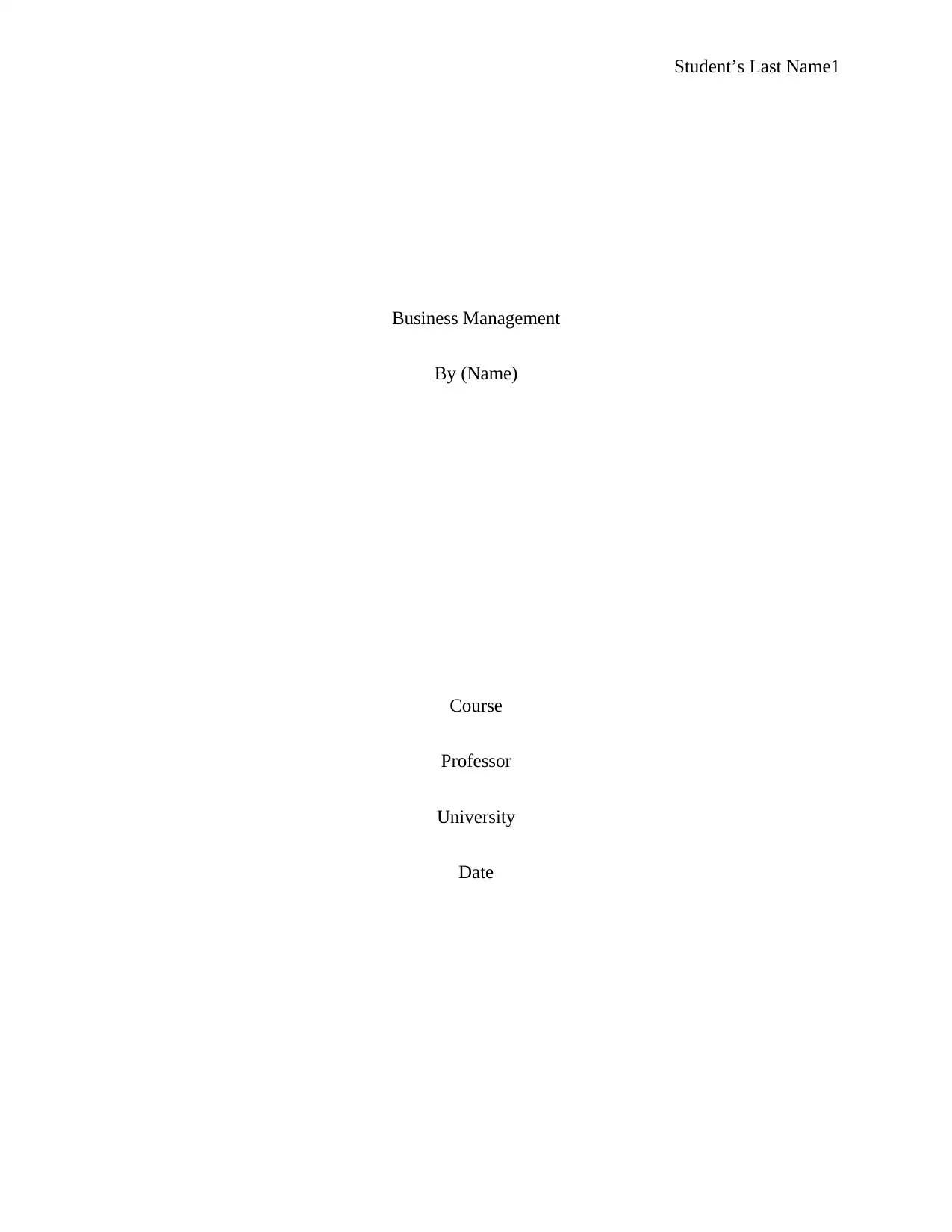
Student’s Last Name1
Business Management
By (Name)
Course
Professor
University
Date
Business Management
By (Name)
Course
Professor
University
Date
Paraphrase This Document
Need a fresh take? Get an instant paraphrase of this document with our AI Paraphraser
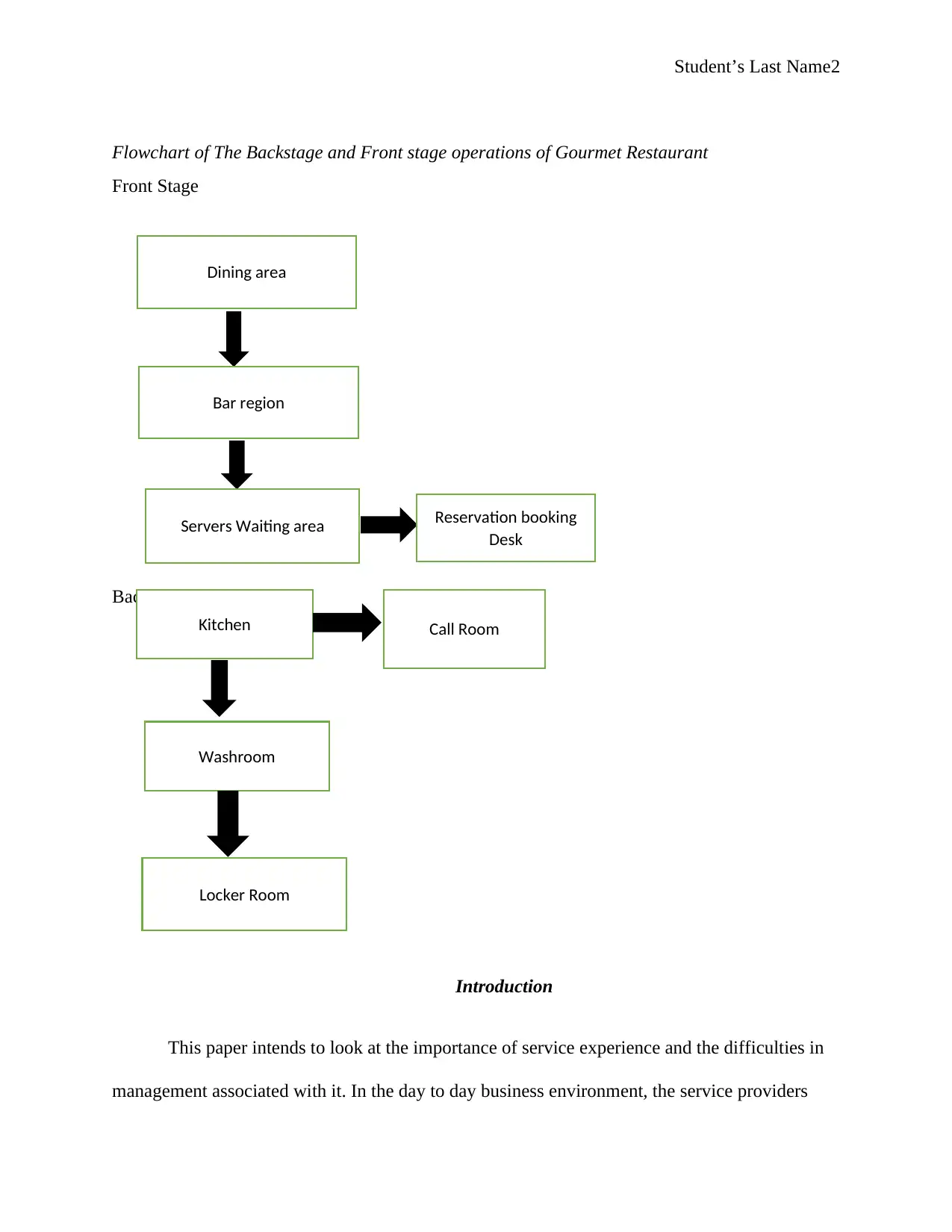
Student’s Last Name2
Flowchart of The Backstage and Front stage operations of Gourmet Restaurant
Front Stage
Back Stage
Gourmet Restaurant
Introduction
This paper intends to look at the importance of service experience and the difficulties in
management associated with it. In the day to day business environment, the service providers
Dining area
Bar region
Servers Waiting area Reservation booking
Desk
Kitchen
Washroom
Call Room
Locker Room
Flowchart of The Backstage and Front stage operations of Gourmet Restaurant
Front Stage
Back Stage
Gourmet Restaurant
Introduction
This paper intends to look at the importance of service experience and the difficulties in
management associated with it. In the day to day business environment, the service providers
Dining area
Bar region
Servers Waiting area Reservation booking
Desk
Kitchen
Washroom
Call Room
Locker Room
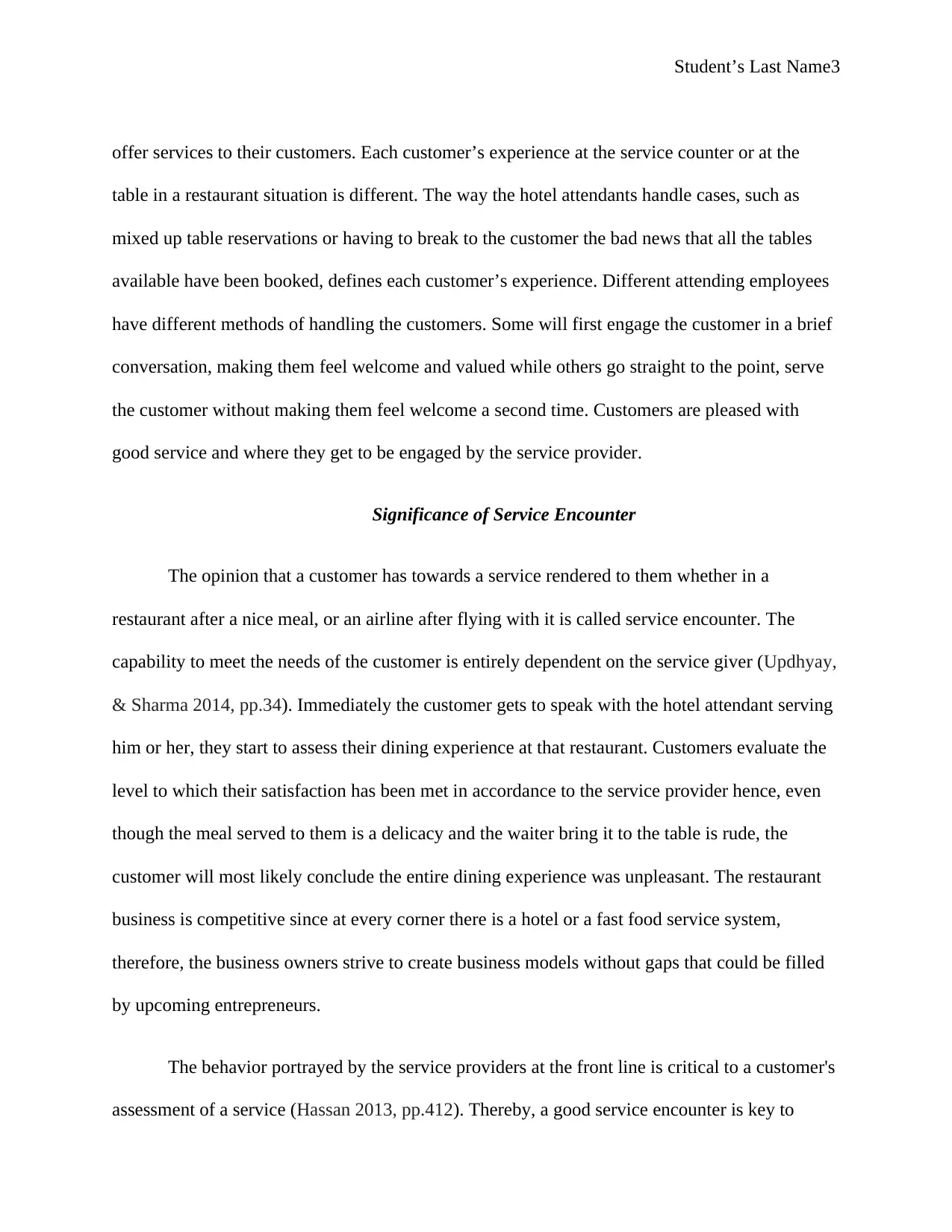
Student’s Last Name3
offer services to their customers. Each customer’s experience at the service counter or at the
table in a restaurant situation is different. The way the hotel attendants handle cases, such as
mixed up table reservations or having to break to the customer the bad news that all the tables
available have been booked, defines each customer’s experience. Different attending employees
have different methods of handling the customers. Some will first engage the customer in a brief
conversation, making them feel welcome and valued while others go straight to the point, serve
the customer without making them feel welcome a second time. Customers are pleased with
good service and where they get to be engaged by the service provider.
Significance of Service Encounter
The opinion that a customer has towards a service rendered to them whether in a
restaurant after a nice meal, or an airline after flying with it is called service encounter. The
capability to meet the needs of the customer is entirely dependent on the service giver (Updhyay,
& Sharma 2014, pp.34). Immediately the customer gets to speak with the hotel attendant serving
him or her, they start to assess their dining experience at that restaurant. Customers evaluate the
level to which their satisfaction has been met in accordance to the service provider hence, even
though the meal served to them is a delicacy and the waiter bring it to the table is rude, the
customer will most likely conclude the entire dining experience was unpleasant. The restaurant
business is competitive since at every corner there is a hotel or a fast food service system,
therefore, the business owners strive to create business models without gaps that could be filled
by upcoming entrepreneurs.
The behavior portrayed by the service providers at the front line is critical to a customer's
assessment of a service (Hassan 2013, pp.412). Thereby, a good service encounter is key to
offer services to their customers. Each customer’s experience at the service counter or at the
table in a restaurant situation is different. The way the hotel attendants handle cases, such as
mixed up table reservations or having to break to the customer the bad news that all the tables
available have been booked, defines each customer’s experience. Different attending employees
have different methods of handling the customers. Some will first engage the customer in a brief
conversation, making them feel welcome and valued while others go straight to the point, serve
the customer without making them feel welcome a second time. Customers are pleased with
good service and where they get to be engaged by the service provider.
Significance of Service Encounter
The opinion that a customer has towards a service rendered to them whether in a
restaurant after a nice meal, or an airline after flying with it is called service encounter. The
capability to meet the needs of the customer is entirely dependent on the service giver (Updhyay,
& Sharma 2014, pp.34). Immediately the customer gets to speak with the hotel attendant serving
him or her, they start to assess their dining experience at that restaurant. Customers evaluate the
level to which their satisfaction has been met in accordance to the service provider hence, even
though the meal served to them is a delicacy and the waiter bring it to the table is rude, the
customer will most likely conclude the entire dining experience was unpleasant. The restaurant
business is competitive since at every corner there is a hotel or a fast food service system,
therefore, the business owners strive to create business models without gaps that could be filled
by upcoming entrepreneurs.
The behavior portrayed by the service providers at the front line is critical to a customer's
assessment of a service (Hassan 2013, pp.412). Thereby, a good service encounter is key to
You're viewing a preview
Unlock full access by subscribing today!
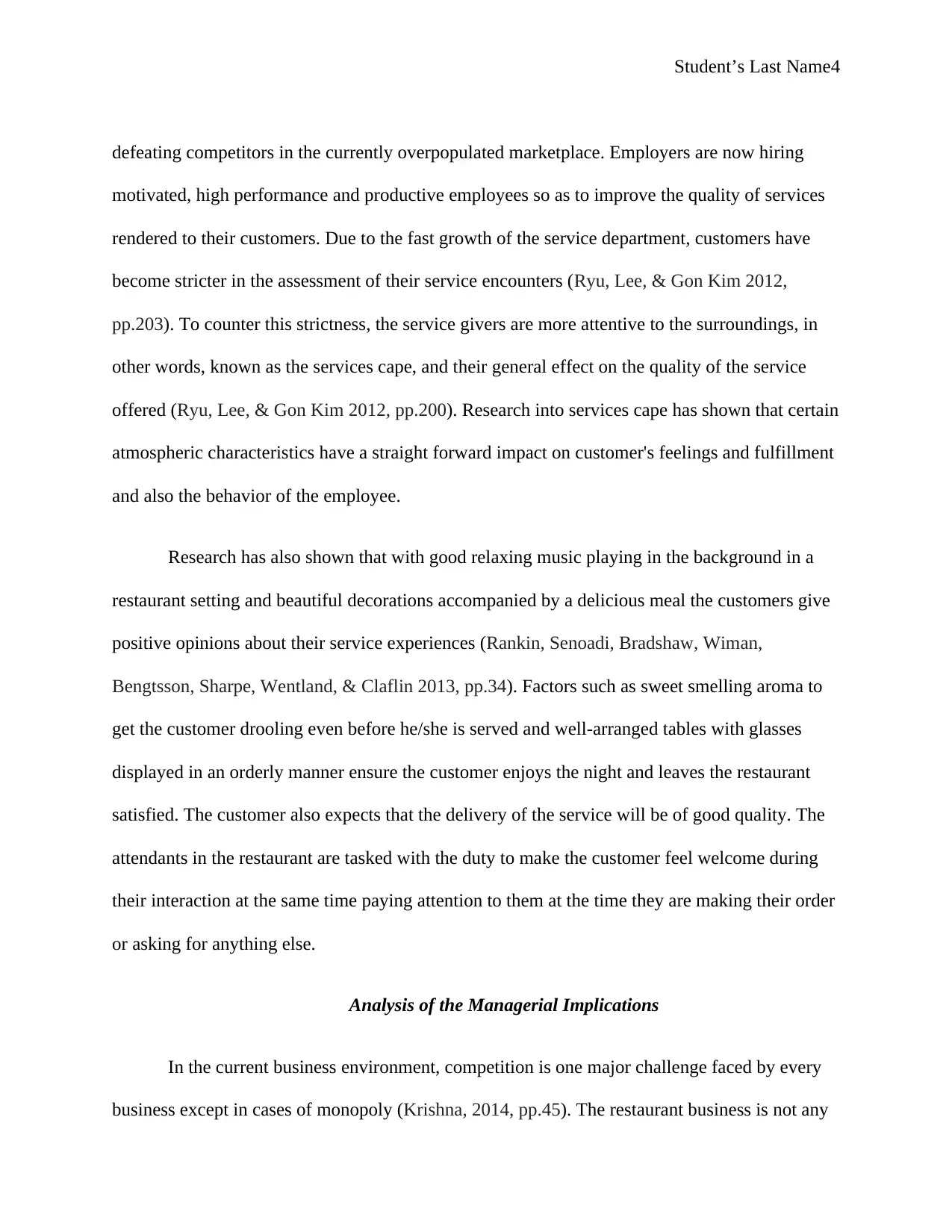
Student’s Last Name4
defeating competitors in the currently overpopulated marketplace. Employers are now hiring
motivated, high performance and productive employees so as to improve the quality of services
rendered to their customers. Due to the fast growth of the service department, customers have
become stricter in the assessment of their service encounters (Ryu, Lee, & Gon Kim 2012,
pp.203). To counter this strictness, the service givers are more attentive to the surroundings, in
other words, known as the services cape, and their general effect on the quality of the service
offered (Ryu, Lee, & Gon Kim 2012, pp.200). Research into services cape has shown that certain
atmospheric characteristics have a straight forward impact on customer's feelings and fulfillment
and also the behavior of the employee.
Research has also shown that with good relaxing music playing in the background in a
restaurant setting and beautiful decorations accompanied by a delicious meal the customers give
positive opinions about their service experiences (Rankin, Senoadi, Bradshaw, Wiman,
Bengtsson, Sharpe, Wentland, & Claflin 2013, pp.34). Factors such as sweet smelling aroma to
get the customer drooling even before he/she is served and well-arranged tables with glasses
displayed in an orderly manner ensure the customer enjoys the night and leaves the restaurant
satisfied. The customer also expects that the delivery of the service will be of good quality. The
attendants in the restaurant are tasked with the duty to make the customer feel welcome during
their interaction at the same time paying attention to them at the time they are making their order
or asking for anything else.
Analysis of the Managerial Implications
In the current business environment, competition is one major challenge faced by every
business except in cases of monopoly (Krishna, 2014, pp.45). The restaurant business is not any
defeating competitors in the currently overpopulated marketplace. Employers are now hiring
motivated, high performance and productive employees so as to improve the quality of services
rendered to their customers. Due to the fast growth of the service department, customers have
become stricter in the assessment of their service encounters (Ryu, Lee, & Gon Kim 2012,
pp.203). To counter this strictness, the service givers are more attentive to the surroundings, in
other words, known as the services cape, and their general effect on the quality of the service
offered (Ryu, Lee, & Gon Kim 2012, pp.200). Research into services cape has shown that certain
atmospheric characteristics have a straight forward impact on customer's feelings and fulfillment
and also the behavior of the employee.
Research has also shown that with good relaxing music playing in the background in a
restaurant setting and beautiful decorations accompanied by a delicious meal the customers give
positive opinions about their service experiences (Rankin, Senoadi, Bradshaw, Wiman,
Bengtsson, Sharpe, Wentland, & Claflin 2013, pp.34). Factors such as sweet smelling aroma to
get the customer drooling even before he/she is served and well-arranged tables with glasses
displayed in an orderly manner ensure the customer enjoys the night and leaves the restaurant
satisfied. The customer also expects that the delivery of the service will be of good quality. The
attendants in the restaurant are tasked with the duty to make the customer feel welcome during
their interaction at the same time paying attention to them at the time they are making their order
or asking for anything else.
Analysis of the Managerial Implications
In the current business environment, competition is one major challenge faced by every
business except in cases of monopoly (Krishna, 2014, pp.45). The restaurant business is not any
Paraphrase This Document
Need a fresh take? Get an instant paraphrase of this document with our AI Paraphraser
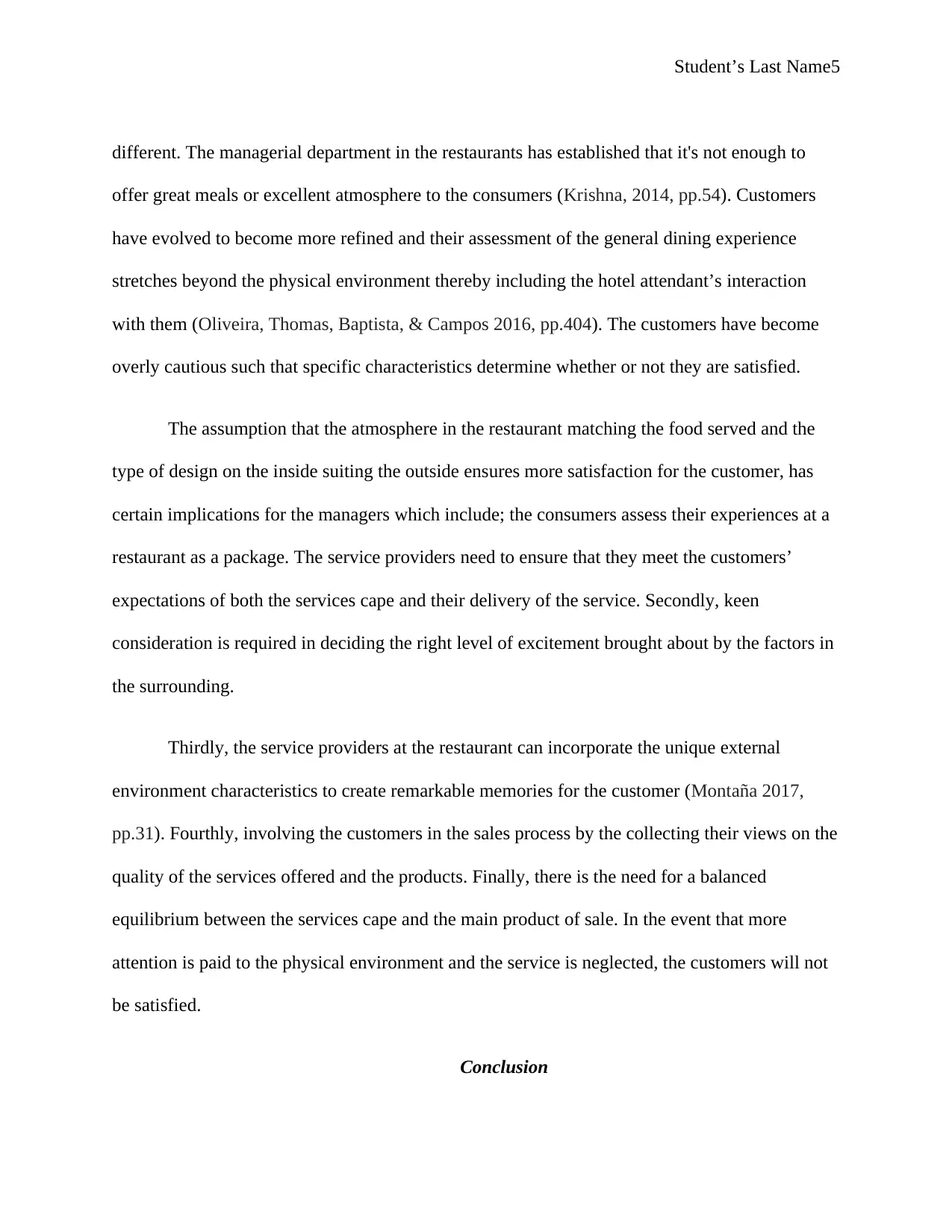
Student’s Last Name5
different. The managerial department in the restaurants has established that it's not enough to
offer great meals or excellent atmosphere to the consumers (Krishna, 2014, pp.54). Customers
have evolved to become more refined and their assessment of the general dining experience
stretches beyond the physical environment thereby including the hotel attendant’s interaction
with them (Oliveira, Thomas, Baptista, & Campos 2016, pp.404). The customers have become
overly cautious such that specific characteristics determine whether or not they are satisfied.
The assumption that the atmosphere in the restaurant matching the food served and the
type of design on the inside suiting the outside ensures more satisfaction for the customer, has
certain implications for the managers which include; the consumers assess their experiences at a
restaurant as a package. The service providers need to ensure that they meet the customers’
expectations of both the services cape and their delivery of the service. Secondly, keen
consideration is required in deciding the right level of excitement brought about by the factors in
the surrounding.
Thirdly, the service providers at the restaurant can incorporate the unique external
environment characteristics to create remarkable memories for the customer (Montaña 2017,
pp.31). Fourthly, involving the customers in the sales process by the collecting their views on the
quality of the services offered and the products. Finally, there is the need for a balanced
equilibrium between the services cape and the main product of sale. In the event that more
attention is paid to the physical environment and the service is neglected, the customers will not
be satisfied.
Conclusion
different. The managerial department in the restaurants has established that it's not enough to
offer great meals or excellent atmosphere to the consumers (Krishna, 2014, pp.54). Customers
have evolved to become more refined and their assessment of the general dining experience
stretches beyond the physical environment thereby including the hotel attendant’s interaction
with them (Oliveira, Thomas, Baptista, & Campos 2016, pp.404). The customers have become
overly cautious such that specific characteristics determine whether or not they are satisfied.
The assumption that the atmosphere in the restaurant matching the food served and the
type of design on the inside suiting the outside ensures more satisfaction for the customer, has
certain implications for the managers which include; the consumers assess their experiences at a
restaurant as a package. The service providers need to ensure that they meet the customers’
expectations of both the services cape and their delivery of the service. Secondly, keen
consideration is required in deciding the right level of excitement brought about by the factors in
the surrounding.
Thirdly, the service providers at the restaurant can incorporate the unique external
environment characteristics to create remarkable memories for the customer (Montaña 2017,
pp.31). Fourthly, involving the customers in the sales process by the collecting their views on the
quality of the services offered and the products. Finally, there is the need for a balanced
equilibrium between the services cape and the main product of sale. In the event that more
attention is paid to the physical environment and the service is neglected, the customers will not
be satisfied.
Conclusion
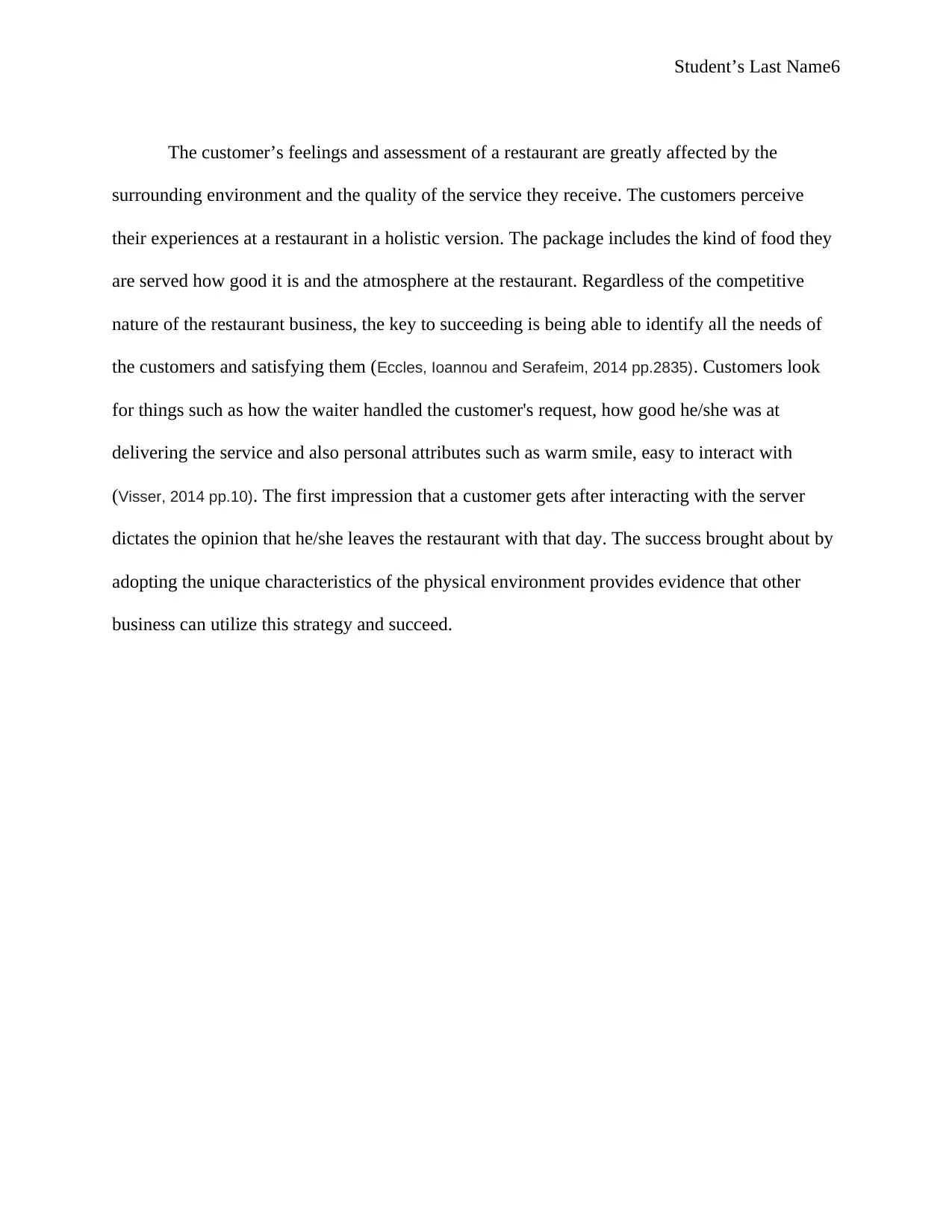
Student’s Last Name6
The customer’s feelings and assessment of a restaurant are greatly affected by the
surrounding environment and the quality of the service they receive. The customers perceive
their experiences at a restaurant in a holistic version. The package includes the kind of food they
are served how good it is and the atmosphere at the restaurant. Regardless of the competitive
nature of the restaurant business, the key to succeeding is being able to identify all the needs of
the customers and satisfying them (Eccles, Ioannou and Serafeim, 2014 pp.2835). Customers look
for things such as how the waiter handled the customer's request, how good he/she was at
delivering the service and also personal attributes such as warm smile, easy to interact with
(Visser, 2014 pp.10). The first impression that a customer gets after interacting with the server
dictates the opinion that he/she leaves the restaurant with that day. The success brought about by
adopting the unique characteristics of the physical environment provides evidence that other
business can utilize this strategy and succeed.
The customer’s feelings and assessment of a restaurant are greatly affected by the
surrounding environment and the quality of the service they receive. The customers perceive
their experiences at a restaurant in a holistic version. The package includes the kind of food they
are served how good it is and the atmosphere at the restaurant. Regardless of the competitive
nature of the restaurant business, the key to succeeding is being able to identify all the needs of
the customers and satisfying them (Eccles, Ioannou and Serafeim, 2014 pp.2835). Customers look
for things such as how the waiter handled the customer's request, how good he/she was at
delivering the service and also personal attributes such as warm smile, easy to interact with
(Visser, 2014 pp.10). The first impression that a customer gets after interacting with the server
dictates the opinion that he/she leaves the restaurant with that day. The success brought about by
adopting the unique characteristics of the physical environment provides evidence that other
business can utilize this strategy and succeed.
You're viewing a preview
Unlock full access by subscribing today!
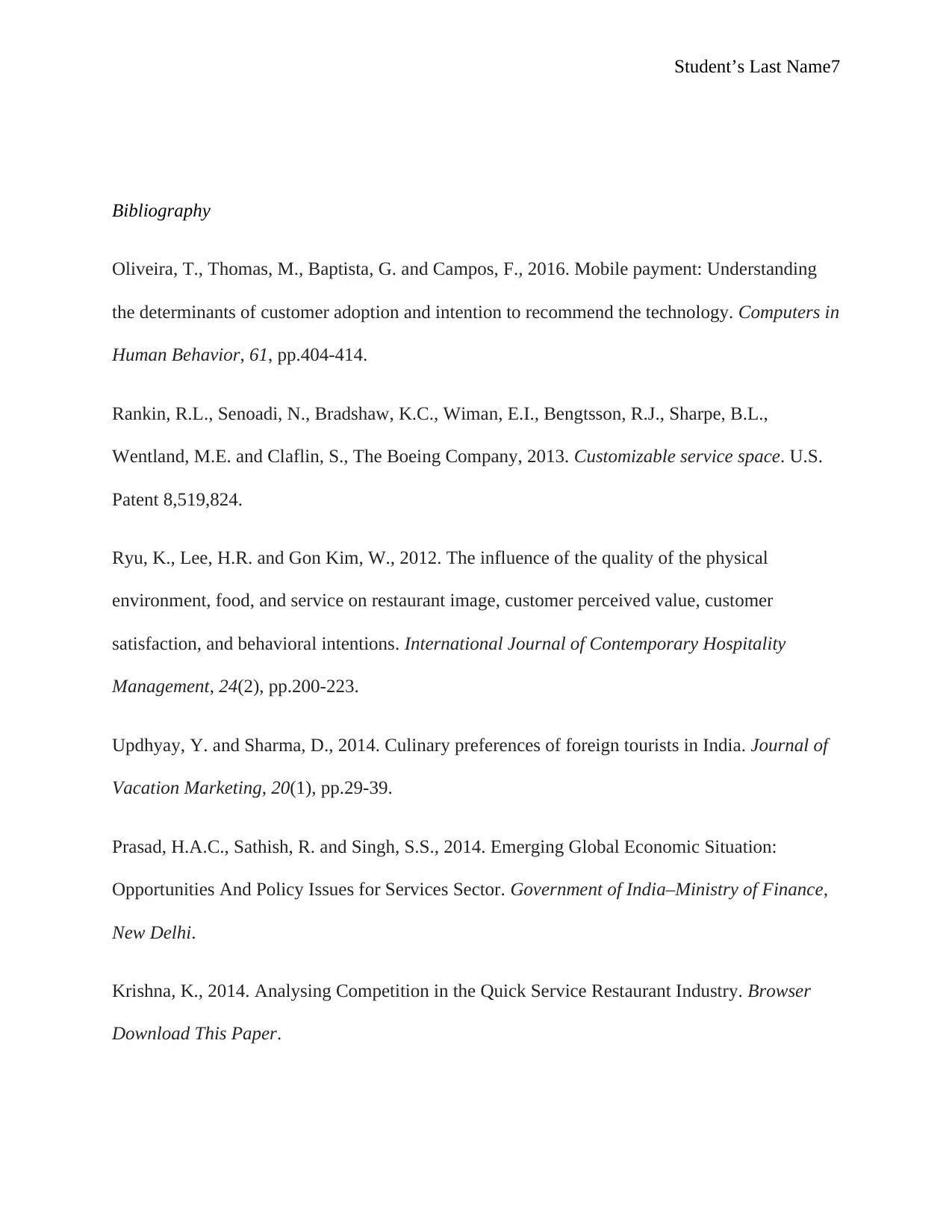
Student’s Last Name7
Bibliography
Oliveira, T., Thomas, M., Baptista, G. and Campos, F., 2016. Mobile payment: Understanding
the determinants of customer adoption and intention to recommend the technology. Computers in
Human Behavior, 61, pp.404-414.
Rankin, R.L., Senoadi, N., Bradshaw, K.C., Wiman, E.I., Bengtsson, R.J., Sharpe, B.L.,
Wentland, M.E. and Claflin, S., The Boeing Company, 2013. Customizable service space. U.S.
Patent 8,519,824.
Ryu, K., Lee, H.R. and Gon Kim, W., 2012. The influence of the quality of the physical
environment, food, and service on restaurant image, customer perceived value, customer
satisfaction, and behavioral intentions. International Journal of Contemporary Hospitality
Management, 24(2), pp.200-223.
Updhyay, Y. and Sharma, D., 2014. Culinary preferences of foreign tourists in India. Journal of
Vacation Marketing, 20(1), pp.29-39.
Prasad, H.A.C., Sathish, R. and Singh, S.S., 2014. Emerging Global Economic Situation:
Opportunities And Policy Issues for Services Sector. Government of India–Ministry of Finance,
New Delhi.
Krishna, K., 2014. Analysing Competition in the Quick Service Restaurant Industry. Browser
Download This Paper.
Bibliography
Oliveira, T., Thomas, M., Baptista, G. and Campos, F., 2016. Mobile payment: Understanding
the determinants of customer adoption and intention to recommend the technology. Computers in
Human Behavior, 61, pp.404-414.
Rankin, R.L., Senoadi, N., Bradshaw, K.C., Wiman, E.I., Bengtsson, R.J., Sharpe, B.L.,
Wentland, M.E. and Claflin, S., The Boeing Company, 2013. Customizable service space. U.S.
Patent 8,519,824.
Ryu, K., Lee, H.R. and Gon Kim, W., 2012. The influence of the quality of the physical
environment, food, and service on restaurant image, customer perceived value, customer
satisfaction, and behavioral intentions. International Journal of Contemporary Hospitality
Management, 24(2), pp.200-223.
Updhyay, Y. and Sharma, D., 2014. Culinary preferences of foreign tourists in India. Journal of
Vacation Marketing, 20(1), pp.29-39.
Prasad, H.A.C., Sathish, R. and Singh, S.S., 2014. Emerging Global Economic Situation:
Opportunities And Policy Issues for Services Sector. Government of India–Ministry of Finance,
New Delhi.
Krishna, K., 2014. Analysing Competition in the Quick Service Restaurant Industry. Browser
Download This Paper.
Paraphrase This Document
Need a fresh take? Get an instant paraphrase of this document with our AI Paraphraser
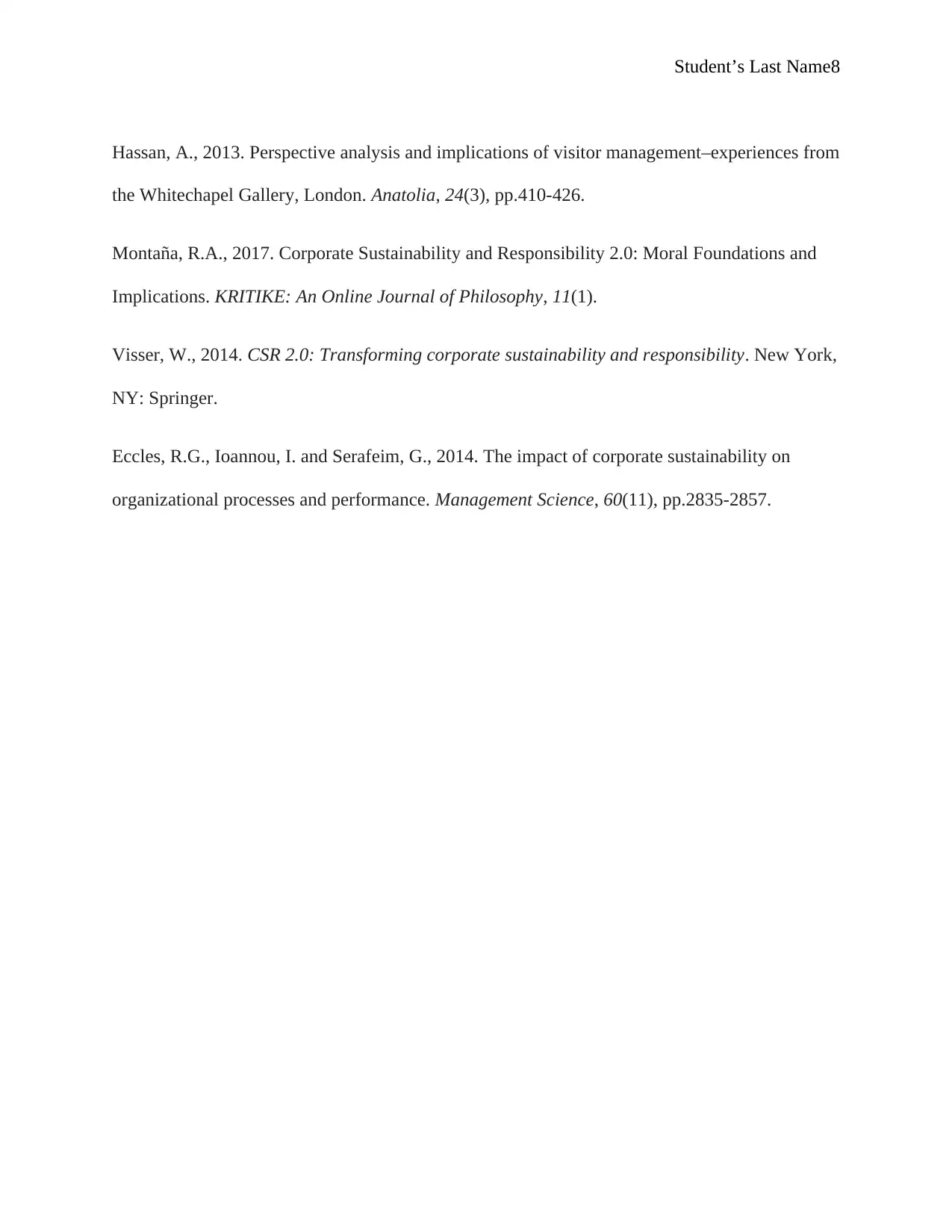
Student’s Last Name8
Hassan, A., 2013. Perspective analysis and implications of visitor management–experiences from
the Whitechapel Gallery, London. Anatolia, 24(3), pp.410-426.
Montaña, R.A., 2017. Corporate Sustainability and Responsibility 2.0: Moral Foundations and
Implications. KRITIKE: An Online Journal of Philosophy, 11(1).
Visser, W., 2014. CSR 2.0: Transforming corporate sustainability and responsibility. New York,
NY: Springer.
Eccles, R.G., Ioannou, I. and Serafeim, G., 2014. The impact of corporate sustainability on
organizational processes and performance. Management Science, 60(11), pp.2835-2857.
Hassan, A., 2013. Perspective analysis and implications of visitor management–experiences from
the Whitechapel Gallery, London. Anatolia, 24(3), pp.410-426.
Montaña, R.A., 2017. Corporate Sustainability and Responsibility 2.0: Moral Foundations and
Implications. KRITIKE: An Online Journal of Philosophy, 11(1).
Visser, W., 2014. CSR 2.0: Transforming corporate sustainability and responsibility. New York,
NY: Springer.
Eccles, R.G., Ioannou, I. and Serafeim, G., 2014. The impact of corporate sustainability on
organizational processes and performance. Management Science, 60(11), pp.2835-2857.
1 out of 8
Your All-in-One AI-Powered Toolkit for Academic Success.
+13062052269
info@desklib.com
Available 24*7 on WhatsApp / Email
![[object Object]](/_next/static/media/star-bottom.7253800d.svg)
Unlock your academic potential
© 2024 | Zucol Services PVT LTD | All rights reserved.